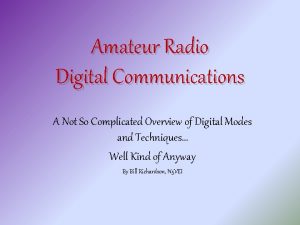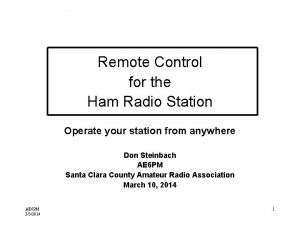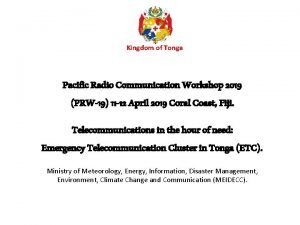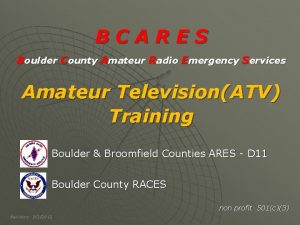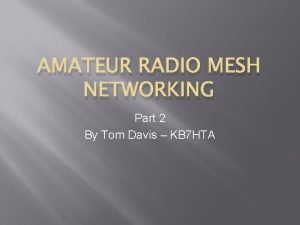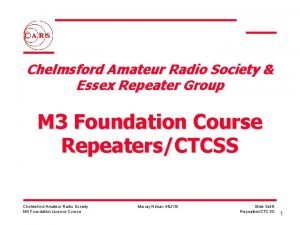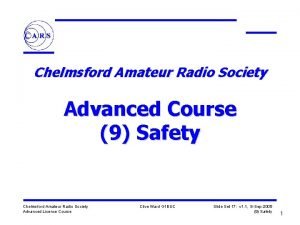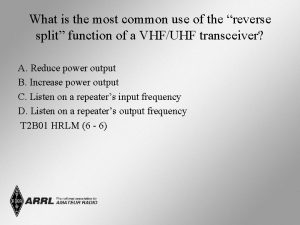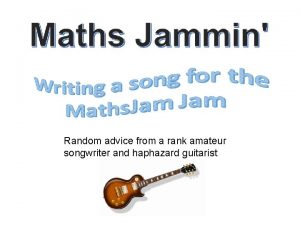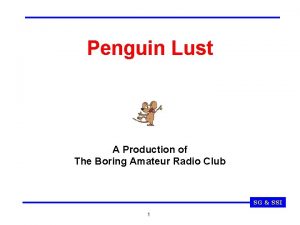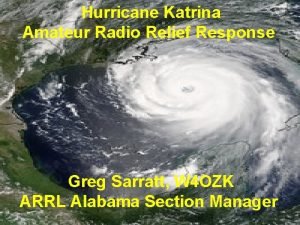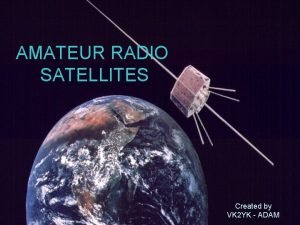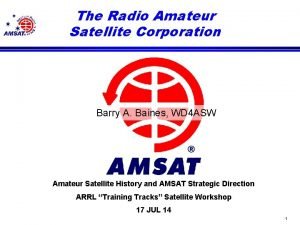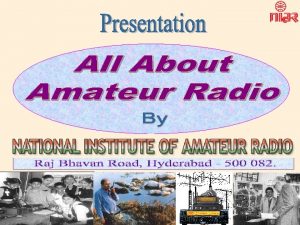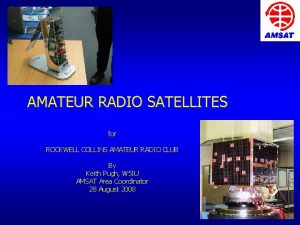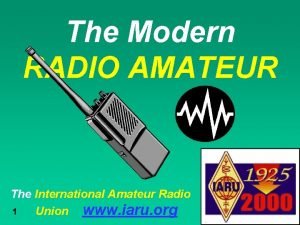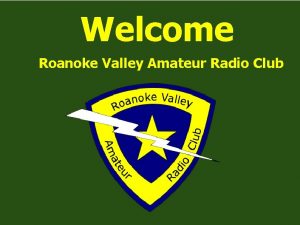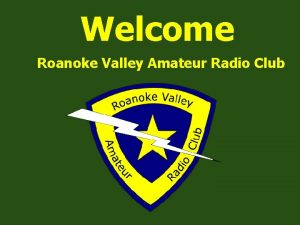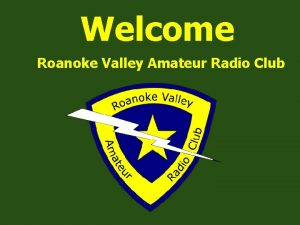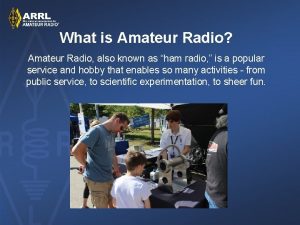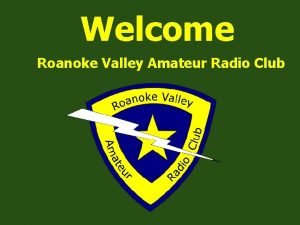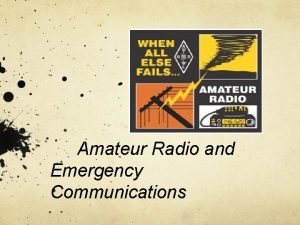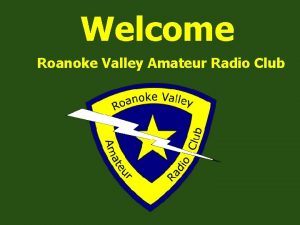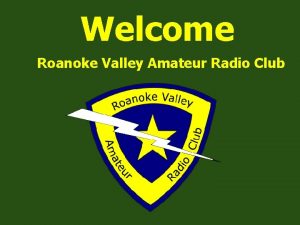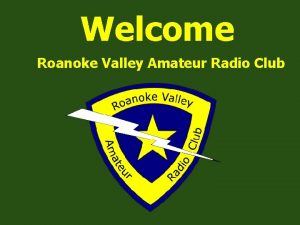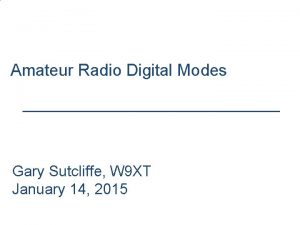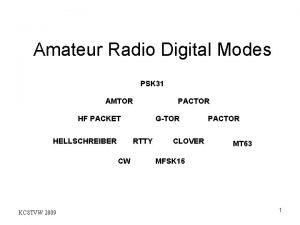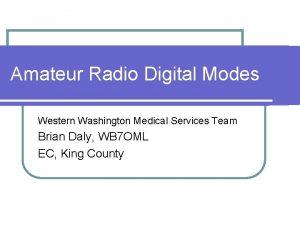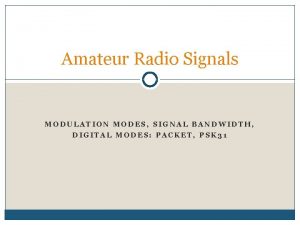Digital Voice Modes for Amateur Radio Digital Voice


















- Slides: 18

Digital Voice Modes for Amateur Radio

Digital Voice Components • Modulation type o This is the modulation scheme used to convert the analog voice to Digital signals. There are three Modulation types; o GMSK (MSK), 16 QAM, � /4 DPQSK and C 4 FM (4 -level FSK). Each modulation type has benefits and disadvantages. • Communication type This Is the method of transmitting or multiplexing the modulated Digital signals. There are two Communication types, FDMA (Frequency Domain Multiple Access) and TDMA (Time domain Multiple Access). • Protocol The protocol is the processing scheme used to convert the data from the transmitter to the receiver. A superior protocol is the most important issue in the design of a Digital radio, and determines the performance of the Digital radio, even If the modulation and the communication types are similar. The Protocol contains the logic that the error check/correction feature depends on. If the error correction is not realized in the receiver, the communication is suspended and the service range in mobile operation will be reduced.

Modulation Types • GMSK The GMSK modulation circuit Is relatively simple, and this method was utilized in earlier cellular telephones as well as the older LMR TETRAPOL system that was used from the 1980's to 1990's. Currently GMSK is being used by D-STAR. • � / 4 DQPSK This is known as the higher-grade modulation method. The � /4 DQPSK modulation's biggest advantage Is that it produces very low distortion. However, it requires linearity (the same as SSB amplifiers) and very complicated electrical circuitry; this also results in very low transmission efficiency. For these reasons this method is not widely used for LMR systems, except for special applications. A good example of this method is the European TETRA system.

Modulation Types (con’t) • C 4 FM (4 -Level FSK) Compared to tile GMSK and � /4 DQPSK modulation systems above (when using the same bandwidth), the C 4 FM (4 -level FSK) circuit can be simplified and the BER (Bit Error Rate) made much better. For this reason, C 4 FM (4 -leval FSK} has replaced GMSK as the main modulation method utilized in the latest LMR radios in the market. Radios using this modulation method are known as APCO P-25 radios are primarily used In tile Public Safety market, such as Police and Fire. An additional type of Digital radio system that uses C 4 FM (4 -level FSK}, and Is very popular In professional commercial markets, is known as DMR (Digital Mobile Radio). DMR Is used primarily In the European and Asian markets, and Is also known as d. PMR.

Communication types • FDMA (Frequency Division Multiple Access) o This technology divides the available frequency band into narrow bandwidth channels. When compared with TDMA the circuitry is simpler. Many communication systems utilize this method, like APCO P-25.

Communication types (con’t) • TDMA (Time Division Multiple Access) Just as FDMA divides the spectrum into narrow bandwidth channels to accommodate many signals, TDMA utilizes time slots; so many signals can share the same frequency, permitting multiple communications. This method has a large advantage in Amateur radio operation because it allows multiple groups to use one repeater on the same frequency. Additionally, when the spectrum is shared by time division, the actual transmission time will be reduced by one-half or more. Thus, battery life will be longer. The TDMA method offers some big benefits to portable radios and repeater users.

Communication types (con’t) • TDMA (Con’t) Dividing the time into two time slots, is called "2 slot TDMA". The system that uses this method is the DMR (Digital Mobile Radio) technology that is used in LMR products. This method was standardized in 2005 by ETSI (European Telecommunications Standards Institute). TDMA has become the standard communication method in the USA and Asian markets. Compared with other digital communication types, the service coverage is wider; the transmitted voice quality is better and clearer, the security performance is more reliable and the battery life is longer. In addition, a single repeater can repeat two communications on one channel. The cost to install one digital TDMA repeater is significantly less than the installation cost of two current technology analog repeaters.

TDMA As explained above, TDMA has a lot of merit, but the circuit design is difficult and requires a high level of development ability, when compared with the FDMA systems. Presently there are only three companies that have developed and released DMR radios into the market. One is Motorola and another is Vertex Standard.

Digital vs. Analog

Digital vs. Analog (con’t) With analog FM modulation, 12 d. B SINAD is considered the standard sensitivity point. In Digital communications, the standard is different. It is the point that can realize a 1 % bit error rate. In comparison, the Analog signal strength of 12 d. B SINAD sensitivity is 3 d. B higher than the digital mode 1% bit error rate level. In Digital communication, if the signal level is stronger than this point, even by a small amount, it is possible to produce clearer RX audio with better S/N. However, if the Digital signal is lower than this point, the audio from the speaker will be intermittent and not understandable. In this case, the analog FM signal has the advantage, even if the signal becomes weaker, by opening the receiver squelch, you may be able to hear and understand what is being transmitted.

Current Modes • D-Star Digital Smart Technologies for Amateur Radio is an open standard digital communication protocol established by the Japan Amateur Radio League (JARL). This protocol was designed for the Amateur Radio Service and ICOM is currently the only major equipment manufacturer making D-STAR gear. See “D-STAR, Digital Voice for VHF/UHF, ” CQ VHF magazine, Winter 2006. Repeater. Book indicates there are 1064 D-Star Repeaters in North America

D-Star

P-25 • APCO 25 The Project 25 radio standard was developed by the Association of Public Safety Communications Officials-International (APCO) primarily for the Public Safety Spectrum. A primary goal of this standard is to enable intercommunication between multiple public safety organizations (e. g. , fire, police, medical). Uses both FMDA and TDMA in different parts of the standard (phase I vs phase II). Can be used trunked or non-trunked. Repeater. Book indicates 170 P-25 Repeaters in North America

Digital Mobile Radio (DMR) • DMR Digital Mobile Radio standard was developed by the European Telecommunications Standards Institute (ETSI). This standard uses TDMA to allow two communication links simultaneously on a single 12. 5 -k. Hz channel. See “TRBO Hits the Amateur Bands, ” CQ VHF magazine, Spring 2012. Motorola’s implementation is called Moto. TRBO. Repeater. Book indicates 508 DMR Repeaters in North America

Current Modes (con’t) • NXDN™ is a very narrowband protocol employing 6. 25/12. 5 KHz FDMA technology (It is generally accepted that 12. 5 k. Hz channel spacing is narrowband as per the FCC mandate. ) Icom/Kenwood Repeater. Book indicates 52 NXDN Repeaters in North America • System Fusion • Repeater. Book indicates 219 System Fusion Repeaters in North America

Current Modes (con’t) • System Fusion (con’t) As Yaesu has introduced C 4 FM, they have made a big issue of C 4 FM being a superior modulation type, especially as compared to the GMSK as used by D-STAR. In practical use, the difference really isn't that great. C 4 FM has four carriers per signal, whereas GMSK has 2, but decoding C 4 FM is inherently more difficult. GMSK isn't just a small modulation used by D-STAR, it's the modulation used by a billion GSM cellphones. The biggest difference in digital communications is what comes on top of the base modulation scheme. System Fusion uses the same AMBE chip from DVSI, that essentially every other digital communications mode uses. There are newer versions of the chip, and the chip supports different compressions and forward error correction (FEC) rates. System Fusion supports 4 digital modes (the radios also do FM); o Voice/Data mode type 1 (DN 1) (Digital Narrow) o Voice/Data mode type 2 (DN 2) o Data Full Rate mode (DW) (Digital Wide) o Voice Full Rate mode (VW) (Voice Wide)

System Fusion (con’t) The modulated signal is 9600 bps (twice that of D-STAR DV) and is composed of repeated frames. The transmission starts with a header frame and then is followed by alternating data and/or voice frames and finishes with a terminator frame. In DN 1, he voice is 2450 bps with 1150 bps FEC and data is 3600 bps. In DN 2, the voice and FEC stay the same, but data rate Is halved an additional layer of 2400 bps of FEC is added. In DW, the entire channel is available for data (7200 bps). in VW, the entire channel is available for voice which is at 4400 bps and FEC is at 2800 bps. At this time, the only way known to transmit data is by sending GPS information or using the optional camera microphone. The protocol includes the users call sign and when transmitted through the repeater, includes the repeaters call sign.

More Info • System Fusion o o • www. yaesu. com http: //www. systemfusioninfo. com/ D-Star o http: //en. wikipedia. org/wiki/D-STAR o http: //www. dstarinfo. com/ o http: //www. icomamerica. com/en/products/amateur/dstar/default. aspx • DMR o o o • P-25 o o • http: //en. wikipedia. org/wiki/Digital_mobile_radio http: //www. dmr-marc. net/ http: //www. dvara. org/ http: //en. wikipedia. org/wiki/Project_25 http: //www. project 25. org/ NXDN o o http: //en. wikipedia. org/wiki/NXDN http: //nxdninfo. com/wp/
 Amateur radio digital communications
Amateur radio digital communications Remote ham radio control
Remote ham radio control Tonga hf radio
Tonga hf radio Boulder amateur radio club
Boulder amateur radio club Ubnt link calc
Ubnt link calc Chelmsford amateur radio society
Chelmsford amateur radio society Chelmsford amateur radio society
Chelmsford amateur radio society Chelmsford amateur radio society
Chelmsford amateur radio society Bbhn
Bbhn Svenskt ramverk för digital samverkan
Svenskt ramverk för digital samverkan Awin radio
Awin radio Where may ssb phone be used in amateur bands above 50 mhz?
Where may ssb phone be used in amateur bands above 50 mhz? Random amateur
Random amateur Amateur lust
Amateur lust Katrina amateur
Katrina amateur Vk amateur
Vk amateur Revenge porn amateur
Revenge porn amateur Amateur sp
Amateur sp Amateur sdx
Amateur sdx
